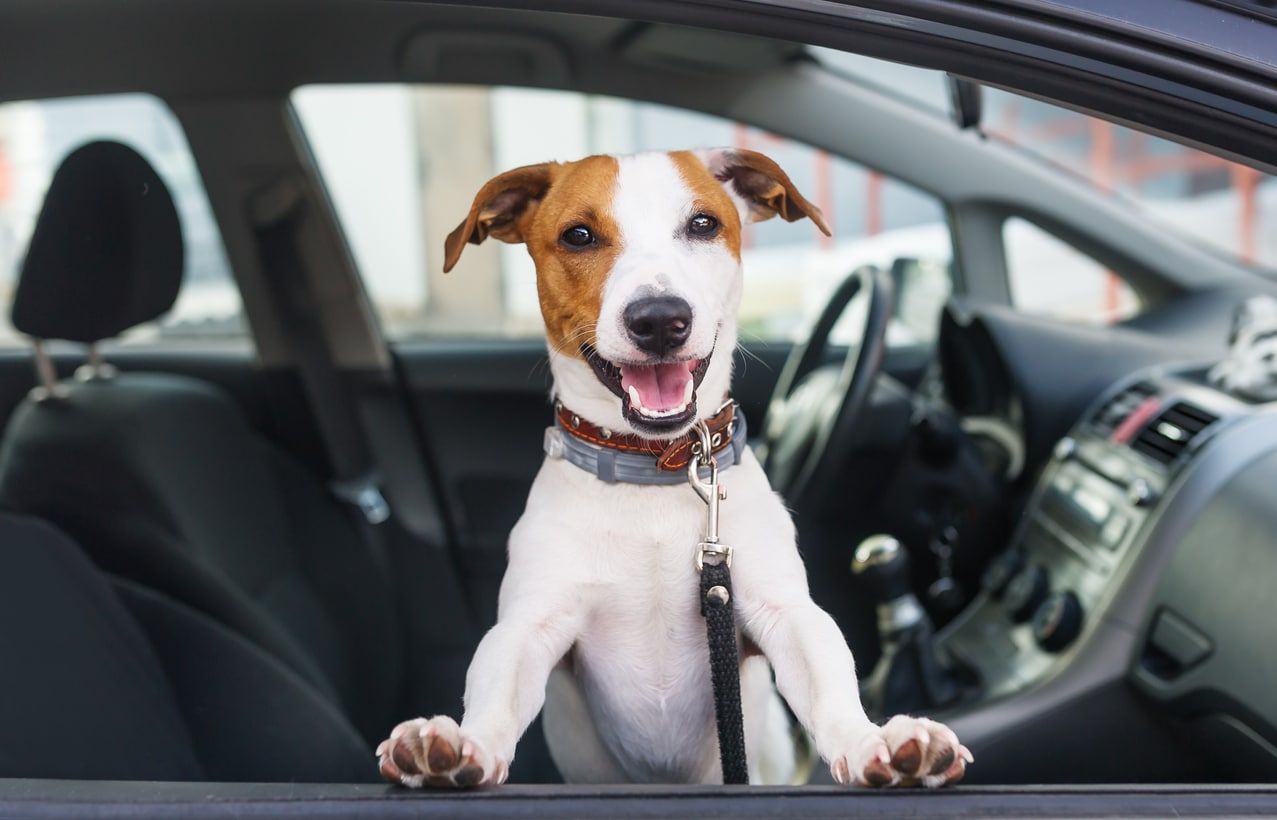It’s no secret that we Brits love our dogs, but we’re also a nation of car enthusiasts. As anyone who owns both will know, keeping your car clean when you tend to bring your dog everywhere with you can often be an uphill battle that can only be fought by changing your habits.
Whether you let your dog ride in the car when you go for weekend walks or only ever bring them along for drives to veterinary visits, we all seem to have different opinions on where dogs should sit, which safety features should be installed and how often to let them sit in the car when you’re driving. We decided to survey British car and pet owners to find out the most common opinions and habits when it comes to driving with our furry friends.
Driving with Dogs
Brits’ Opinions on Driving with Dogs
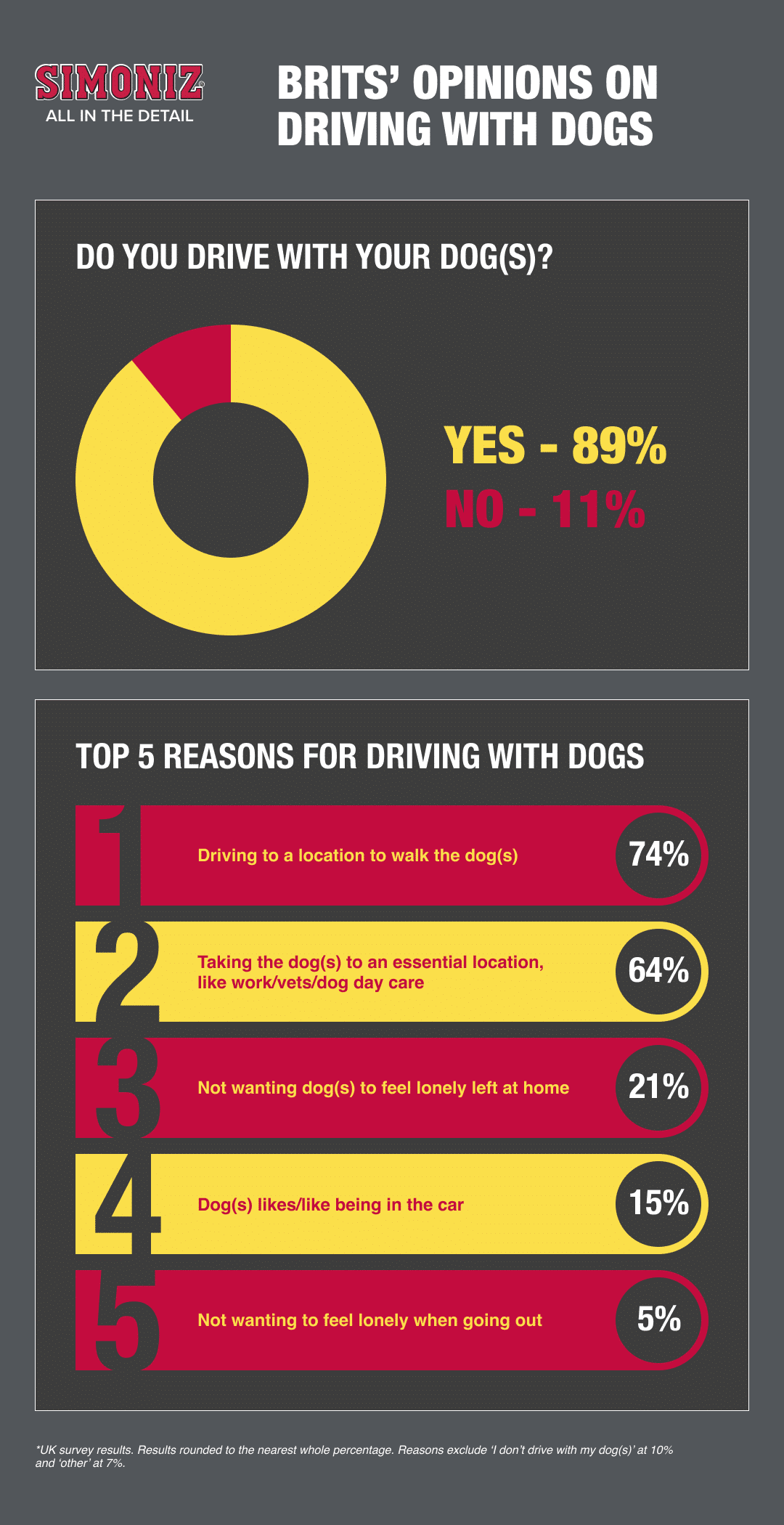
First, we wanted to know how many Brits drive with their dog in the car. Our research uncovered that almost 9 in 10 Brits (89%) do this, which leaves just 11% who choose not to. This alone proves that many motorists are dog lovers.
With so many Brits driving with their dogs by their side, we also wanted to find out why so many bring them along for a drive. We found that the most common reason that Brits are driving with their dog is to go somewhere for a dog walk (74%). Whether the destination is a park, nature trail or beach, it seems that many dog owners enjoy travelling to different locations with their dogs to switch up the scenery on their walks. The second most popular reason for driving with a dog in the car seems much more practical since 64% said they drive their pet to an essential location like the vets or work. This could be because these locations are too far to walk or would be stressful to travel to on public transport. Driving might also be the preferred way to get to these locations because there might not be another option available.
Loneliness also plays a huge factor in whether we choose to drive with our dogs, with 1 in 5 admitting that they bring their dog along so that their dog doesn’t feel lonely at home. 5% also feel lonely going out without their dog and enjoy their company whilst driving.
Brits’ Driving Habits with Dogs
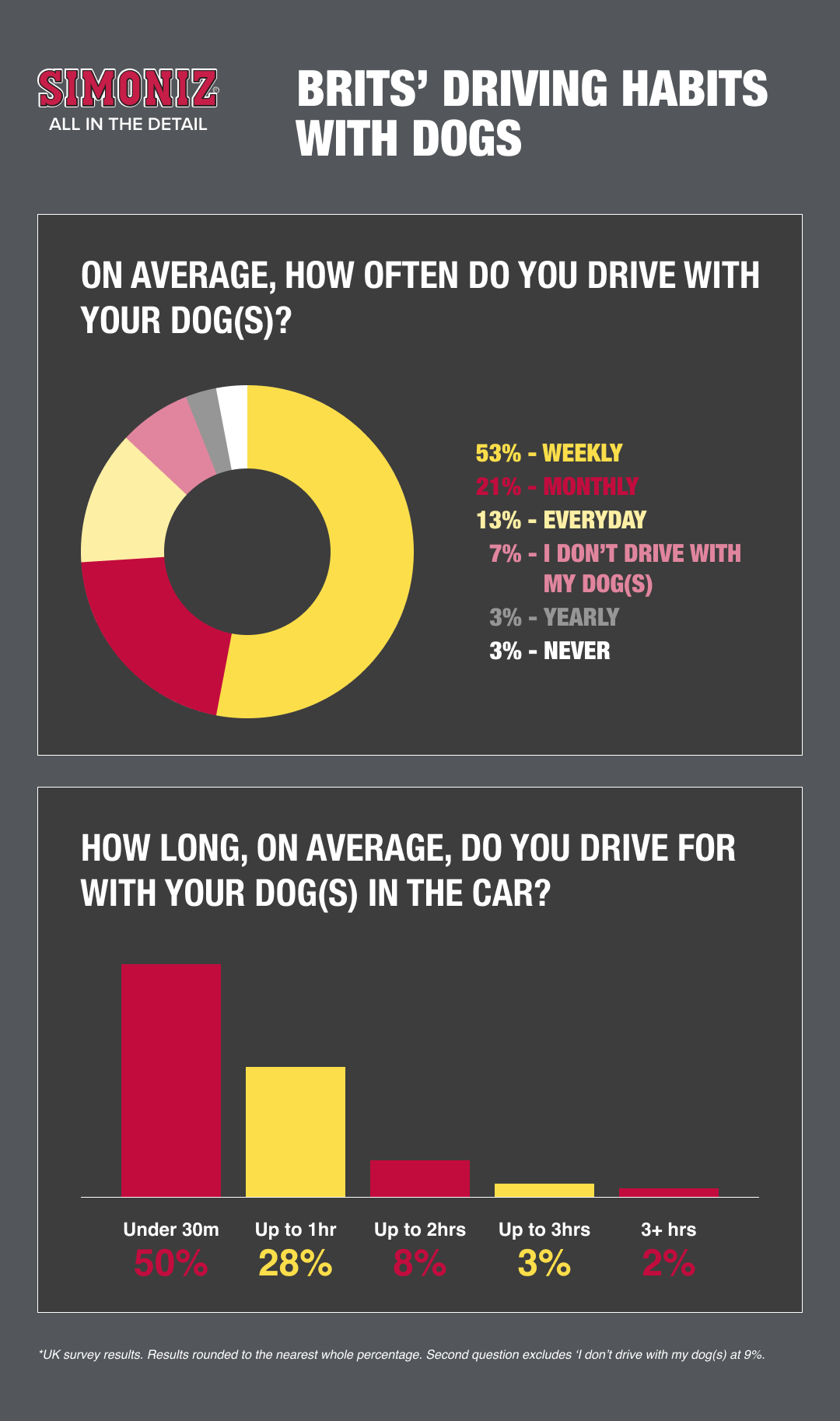
When asked how often their dog rides in their car, more than half of motorists said weekly. Meanwhile, 1 in 5 will drive with their furry friend every month, and 1 in 10 are accompanied by their dog as a passenger each day. On the other hand, only 7% choose not to drive with their beloved pet, and just 3% will only drive with them in the car once a year. This suggests that most motorists hit the road with their pooch more often than not and those who leave their dogs at home are in the minority.
When it comes to the length of time that Brits are willing to drive with their dogs, we found that the majority of Brits (50%) seem most comfortable completing quick trips. Almost 3 in 10 say they drive for up to an hour with their pet, while 8% drive for up to 2 hours with their dog in the car.
A small percentage of Brits don’t take their dogs on long journeys, as only 3% admitted to driving up to 3 hours and an additional 3% would drive for over 3 hours.
Behaviour & Habits of Dogs in Cars
Are Brits Distracted by their Dog(s) while Driving?

The good news is that almost 7 in 10 drivers said that their dog doesn’t distract them whilst driving. However, 17% admitted that they’re sometimes distracted by their dog and 1 in 25 always feel distracted by their furry friend whilst on the road.
Distractions inside the car can be dangerous if they take too much attention away from driving. So if you find that you’re being distracted by your dog, it might be worth researching ways that you can minimise this. For example, netting and restraints can be installed to prevent them from moving around the car.
How Our Dogs Feel & Behave Towards Cars
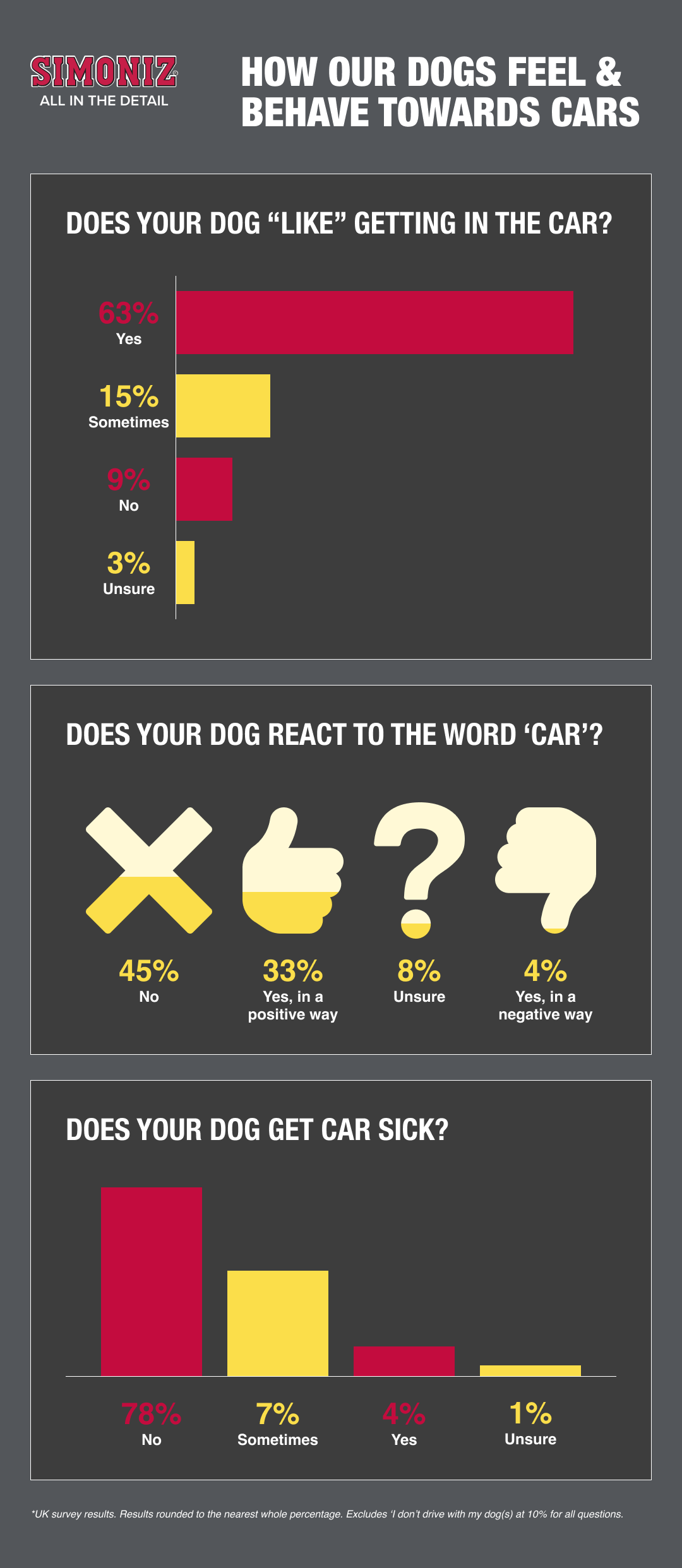
Any dog owner will know that certain trigger words and visual cues can lead to different reactions. So when it comes to hearing the word ‘car’ or seeing a car, it’ll be unsurprising that we found variation in how owners say their dogs feel and respond.
When asked about how their dog reacts to hearing the word ‘car’, almost half of Brits (45%) said their dog doesn’t react. The second most common reaction was positive, with one-third saying their dog has a good emotional response to hearing the word. This means they most likely have a positive association with cars which is most likely to be from good past experiences when they’ve travelled somewhere.
Similarly, we found that 3 in 5 motorists said their dog is always happy to jump into the car, and 15% said their dog likes it sometimes. Sadly, nearly 1 in 10 revealed that their dog doesn’t like getting into the car which could be a reason why some motorists don’t ever bring their dog along on car rides.
Car sickness can also be a worry for pets, although luckily for our motorists it seems that the majority (78%) haven’t experienced this with their dogs. Unfortunately, 7% of Brits’ dogs sometimes get car sick and 4% said their dog does get car sick. This can also put motorists off driving with their dogs for any reason since they’d prefer to not need to clean up after them.
Do Brits Allow their Dogs to Stick their Heads out of the Window?
Allowing dogs to stick their heads out of the car window isn’t necessarily illegal, but this is usually a sign that the dog isn’t properly restrained. Despite this, nearly 1 in 10 said that they sometimes let their dog hang its head out of the window and 6% let them do this all the time. While it might seem like a good idea to let your furry friend enjoy the fresh air and experience different smells and sights, pet owners could be putting their dog at risk of injury from passing cars and debris being brought up from the roads.
Where do Brits Allow their Dog(s) to sit in the car?

Motorists seem to have different habits and opinions on where they feel a dog should sit in the car. Nearly half of Brits (46%) place their dog in the back seat whilst driving, while a quarter revealed that their furry friend stays in the boot of the car when they’re on the road. Almost 1 in 10 said they prefer their dog to be riding shotgun in the front seat. This could vary based on the size of the car and the dog, alongside how many dogs are in the car. For example, it might not be the best idea to have a small dog in the back seat or the boot, while this might be the best place for a larger breed to sit.
After a muddy walk, 4 in 10 motorists place their dog in the back seat compared to 46% who place their dog in the back seat after a normal walk. The car boot becomes the most favourable place to put dogs after a muddy walk, as 32% of participants place their dogs here when they’re muddy. This might be because the boot is easier to clean, but it could also be down to the ‘wet dog’ smell which can be contained better in the boot of most cars.
Do Brits allow multiple dogs in their car?
Of those who said they have multiple dogs, we found that only 5% wouldn’t put them all in the car at the same time. These pet owners might have purchased bigger vehicles to accommodate their dogs better or could own multiple smaller dogs that are easier to fit into a car.
1 in 10 said that they always place multiple dogs in the car at the same time (12%) compared to the 7% who sometimes put all of their dogs in the car at the same time.
Would Brits Ever Leave their Dog in the Car?
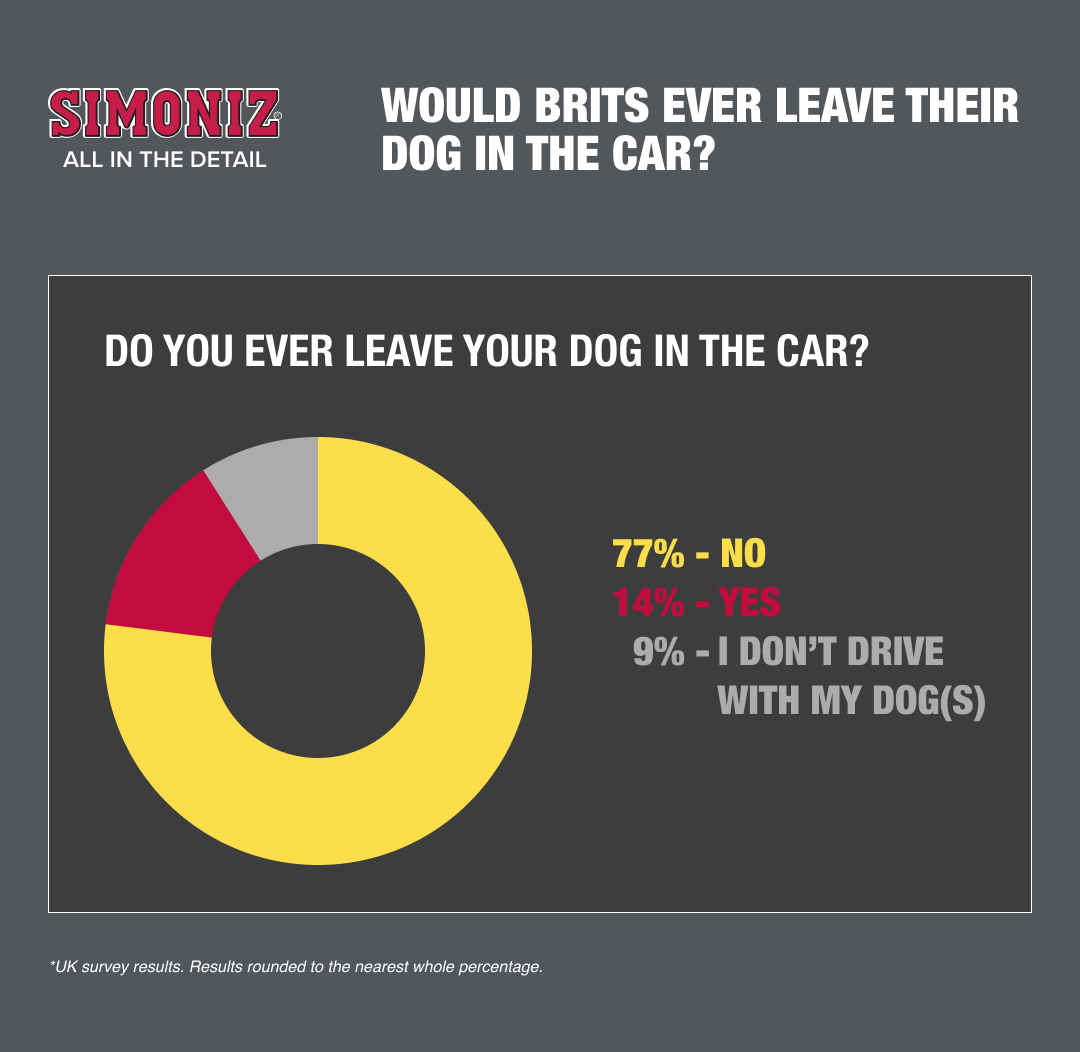
14% of motorists admitted they would leave their dog in the car when asked. While this is a considerable number of people, nearly 8 in 10 Brits don’t ever leave their dog in the car. Leaving dogs in the car can be dangerous in hot weather especially, although it’s also not recommended to leave pets in a cold car. Regardless of the weather, dogs shouldn’t be left longer than a few minutes if you can help it.
Cleaning Habits for Driving with Dogs
Most Popular Ways Brits Protect Car Interiors when Driving with Dogs
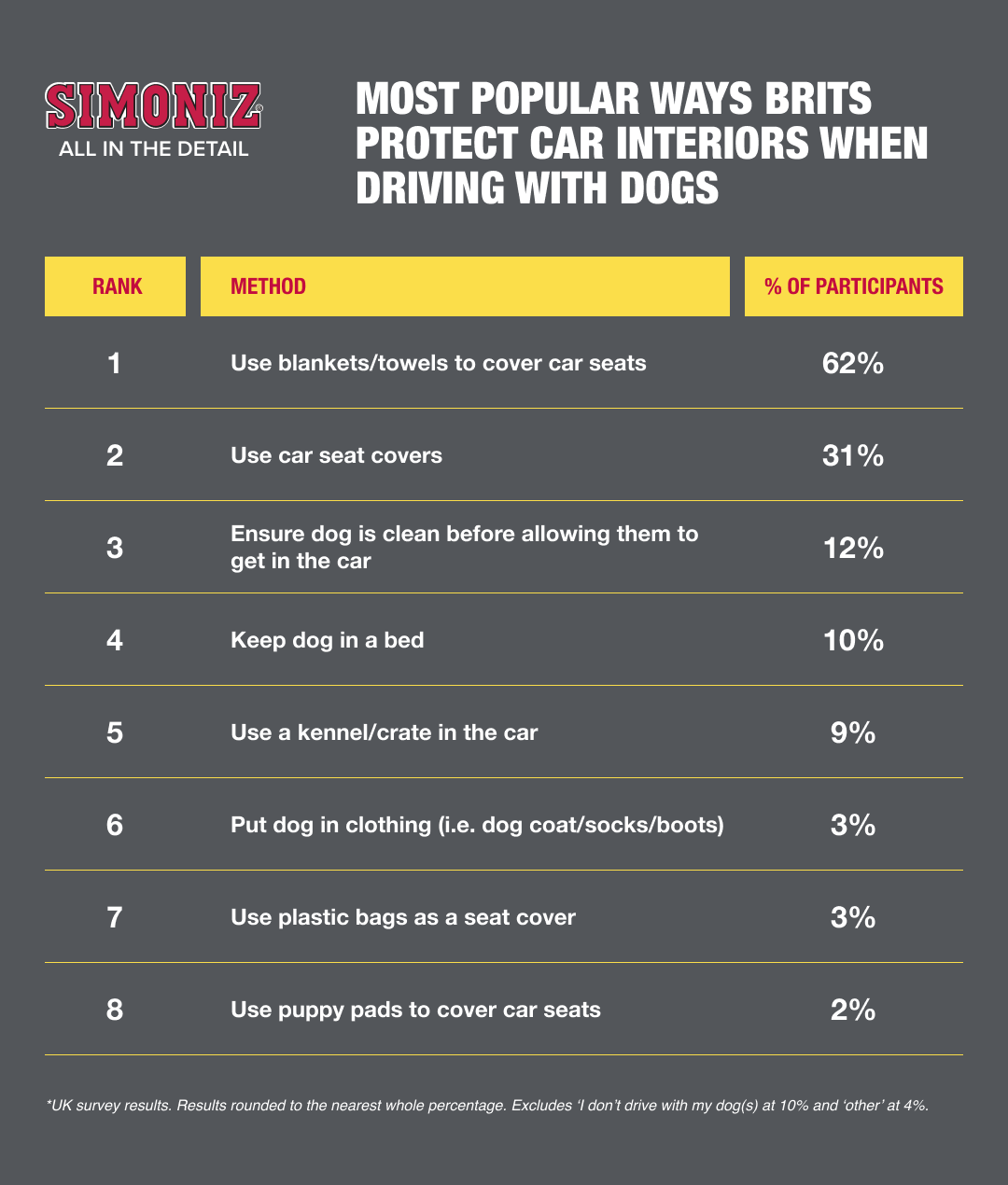
For those who let their dogs sit in the car, one of the main challenges can be protecting the car’s interior from muddy paws. The most popular way that motorists choose to protect their car when planning to drive with dogs is to use blankets or towels as seat covers (62%). This is an inexpensive way to keep the car’s interior clean since most people have extra towels and blankets lying around. Another 3 in 10 also go down the route of covering the seats, although they go the extra mile by using proper seat covers.
12% of motorists simply check their dog is clean before allowing them to get into the car. Whether this means towelling them down or checking their paws for mud, a quick check can prevent any unwanted dirt from reaching the car’s interior.
Most Popular Ways Brits Clean Car Interiors after Driving with Dog(s)

Cleaning car interiors after driving with dogs can ignite fear in many motorists. Dirt and mud can quickly become lodged in between seats and start seeping into the fabric of upholstery. We wanted to know the most popular ways to clean a car after driving with dogs.
Our survey uncovered that nearly half of Brits (45%) are most likely to give their car a quick clean/wipe over when their car interior gets dirty after their dog has been in the car.
13% prefer to deep clean their car after it becomes dirty. This means they’ll use specialist products to ensure their car is properly cleaned each time their dog brings dirt into the vehicle. Deep cleaning is recommended because this prevents dirt from becoming ingrained in the surfaces and causing issues later down the line.
Driving with a Dog & Car Cleaning Habits
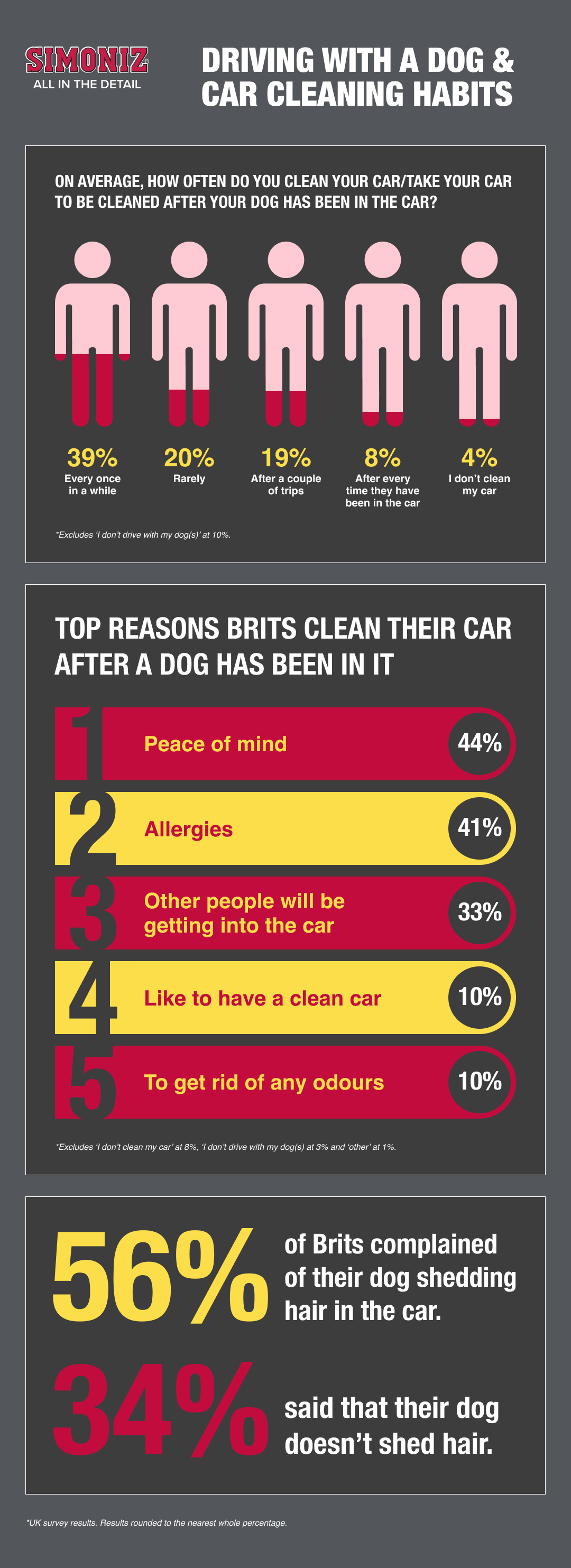
When it comes to car cleaning habits, we found that the majority of Brits (39%) only clean their car once in a while when their dog has been in it, while 8% are more strict and clean it after each trip their dog takes in the car. However, 1 in 5 respondents revealed that they rarely clean their car after their dog has been in it. On the other hand, 19% of participants said that their car is cleaned every couple of trips. It’s a good idea to clean the interior after a dog has been in the car, but if they don’t tend to get dirty, it’s okay to wait longer between cleaning sessions.
A small percentage of respondents admitted that they clean their car every time their dog has been in the car (8%), while 4% said they don’t clean their car at all. Among those who clean their car, 44% do it for their peace of mind, while 41% do it because of allergies. Meanwhile, 3 in 10 respondents admitted that they clean their car purely because they have other people getting into the car (33%).
The survey also revealed that 10% of Brits generally like to have a clean car, while 10% feel the need to remove odours. Except for a surprising 8% who don’t clean their car after their dog has been in it, it seems that most Brits prefer staying on top of their cleaning routine when their dog is a frequent passenger.
Finally, nearly 6 in 10 (56%) respondents said that their dog doesn’t shed in the car, while 34% revealed that their dog does shed all over the car. Pet hair can be difficult to remove and can build up quickly.
Simoniz Top Tips for Cleaning a Car After a Dog has been in it
Whether your back seats are covered by a thick layer of pet hair or mud seems to have landed on every surface of your car’s interior, we’re here to offer our top tips for keeping your car clean after letting a dog come along for the ride.
- Use your household vacuum to remove hair from carpets and upholstery using a lifting motion for best results.
- Invest in a dedicated pet hair cleaning brush designed to remove pet hair from a variety of surfaces, including the carpets and seats in cars. Choose one that’s compact and keep it in the glovebox or boot for use on the go.
- Quickly remove stains, odours and ingrained dirt with the Simoniz Upholstery & Carpet Cleaner.
- Kill bacteria, eliminate odours and keep the car interior smelling fresh with Simoniz Car Sanitiser.
- Leave the windows down to air out any bad smells after a dog has been in the car.
- Ensure all interior surfaces are dried thoroughly if your dog has been in the car after getting wet.
Safety Measures for Driving with Dogs
Safety Measures for Driving with Dogs
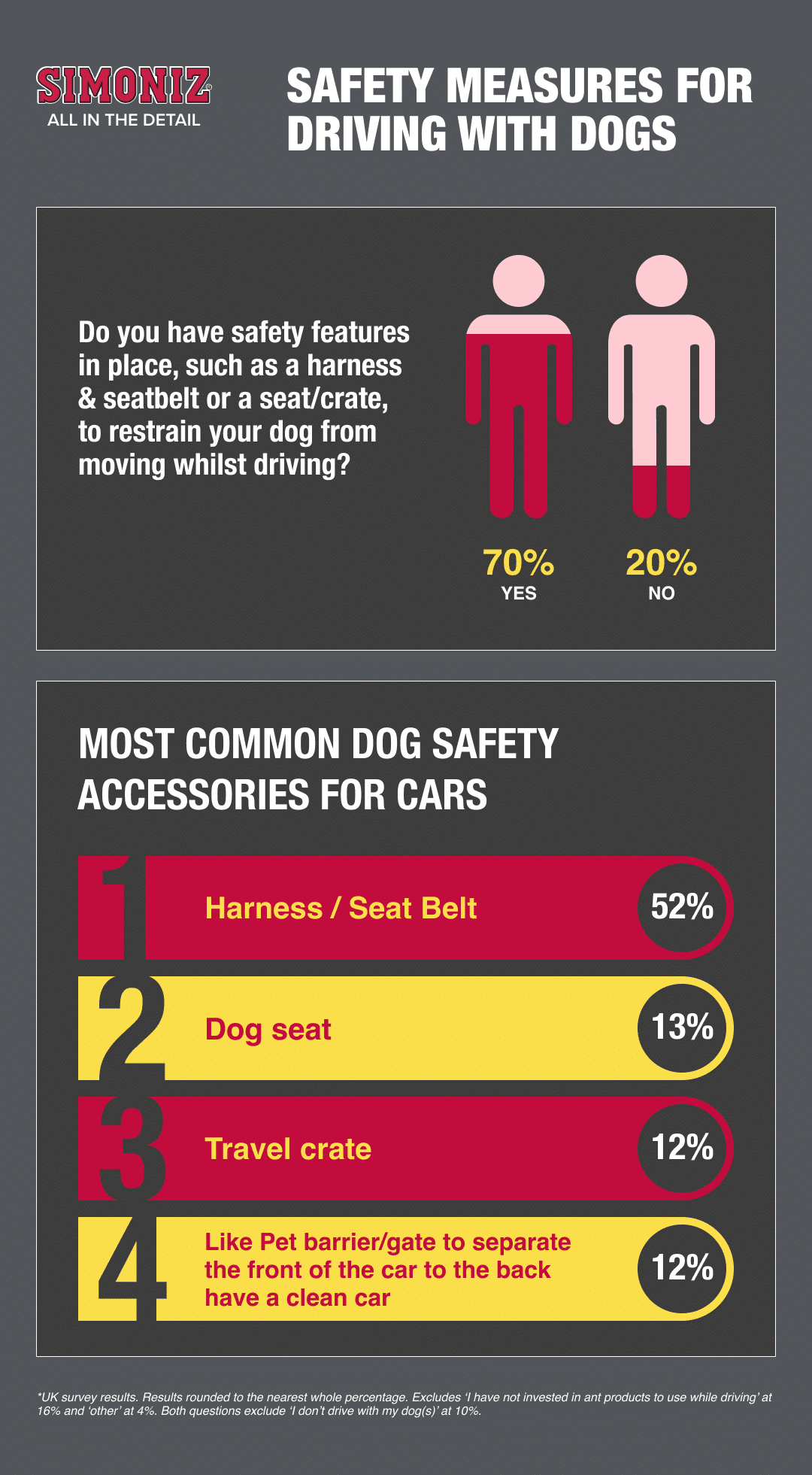
The Highway Code states that dogs and any other animals must be suitably restrained whilst in a vehicle to prevent driver distractions and unnecessary injury to themselves or others in the event of an accident. So with this rule in place, we thought it would be interesting to find out how many dog owners have safety measures in place in their cars.
70% of Brits have safety features installed for their dogs when travelling in a car. These features include a harness and seatbelt that restrains the dog from moving while driving. However, two out of ten motorists don’t have any safety features for their pets.
The most commonly used safety accessory is a harness or seatbelt, with 52% of Brits using this method. 16% of drivers admit to driving with their dogs but have not invested in any safety products.
Only one in ten drivers have invested in dog seats, travel crates, pet barriers, or gates. 13% of drivers have invested in dog seats, while 12% have invested in travel crates and pet barriers/gates respectively.
Most Common Reasons for Not Having Safety Accessories in a Car
The top reason why Brits don’t have safety measures in place is because their dog is well-behaved in the car (19%). A further 5% of participants said that they only complete small trips, therefore it’s not worth investing in any products. Even though this is a rule that motorists should be following, it seems that a select few don’t think they need to comply.
Additional Findings
Regional Results
Do Motorists Across the UK Drive with their Dogs?
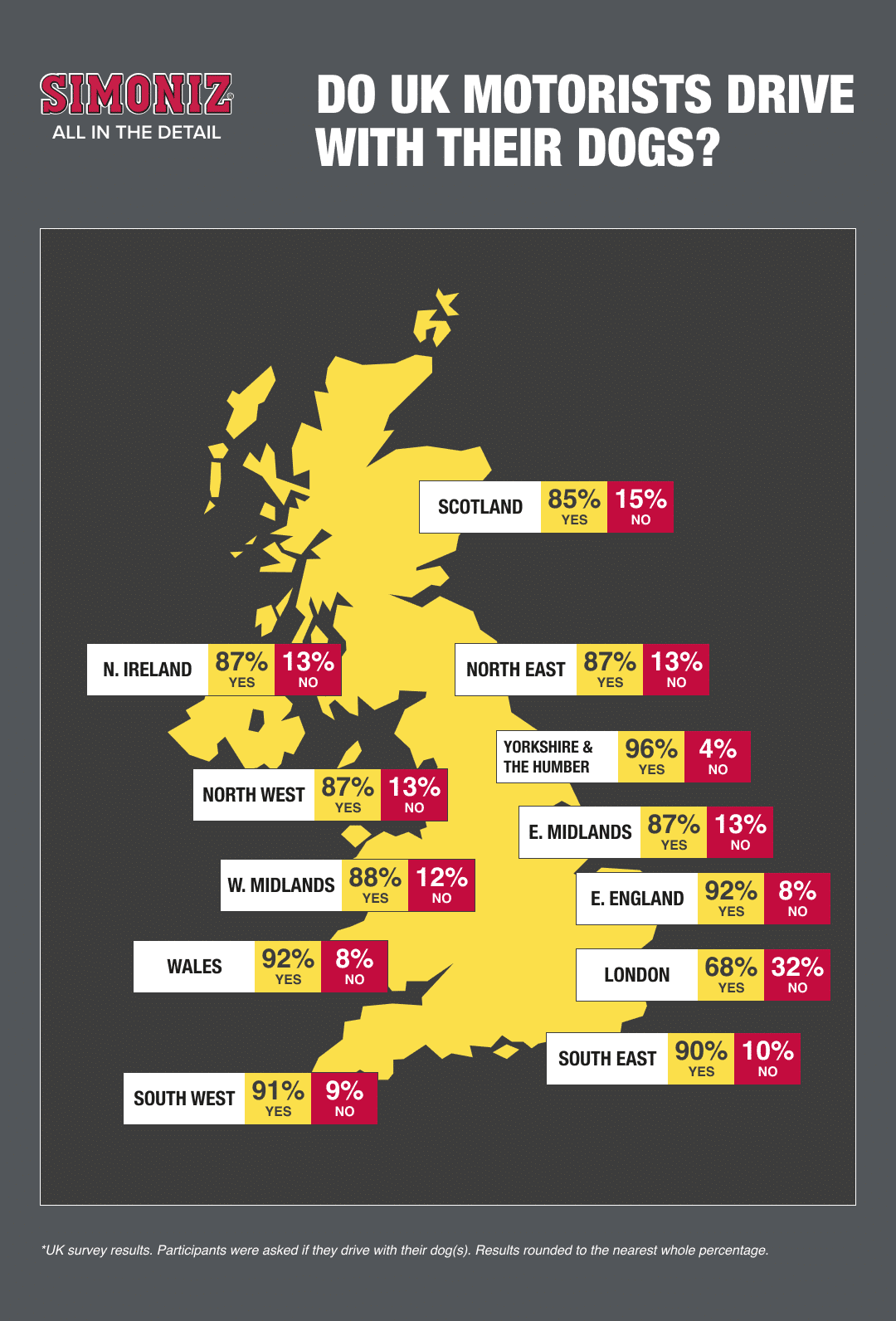
So how do our results differ depending on which region the motorists are from? Here are our most interesting regional findings:
- The majority of Brits across all regions have safety features in place to restrict their dogs from moving in the car whilst driving.
- Wales has the highest percentage of motorists without safety features installed for their pets (30%).
- The majority of motorists who drive with their dogs weekly are in the East of England. 4 in 5 have also implemented safety features, which is the highest percentage across all regions.
- Northern Ireland has the highest percentage of those who never choose to drive with their furry friend, with 13% saying this.
- Over 1 in 5 motorists in Scotland drive with their furry companion every day, which is the highest percentage across all regions.
- The majority of participants across the UK wouldn’t leave their dog in the car. However, motorists in the South West and Scotland are most likely to leave their dog in the car (23%).
- Nobody in Northern Ireland said they would leave their dog in the car.
Generational Results
When we split the results by generation, we found a few interesting insights and differences.
When asked about whether they drive with their dogs, we found that everybody in Gen Z and the Silent Generation said they do. Baby Boomers had the second highest percentage of those who bring their furry friend along on car trips (91%), while Millennials and Gen X were least likely to drive with dogs in the car (88%). However, the percentages were high for all generations, suggesting that there isn’t much difference in this habit.
When we asked about the frequency of the journeys, we found some differences in habits. Baby Boomers were most likely to drive with their dogs daily (17%), while Gen Z had the highest percentage of those who drive with their dogs each month. This could be because people in Gen Z have less free time to take their dogs out on a drive than those in the Baby Boomer generation.
The majority of participants across all generations have safety features in place to restrain their dogs from moving while the car is in motion. Generation Z had the highest percentage of those saying that they have installed safety products into their car (85%). With laws being put into place around suitable restraints for pets and safety measures that owners must take, this could affect the number of people who have these measures in place in the future.
Comparative Results
What comparisons can be made from our results?
Our survey found that drivers with one dog are slightly less distracted by their pets while driving than those with multiple dogs. 20% of single dog owners get distracted by their dog, compared to over a quarter of multiple dog owners. Owners of multiple dogs are also slightly more likely to have safety features installed, with 77% having them versus 68% of owners of just one dog. However, this doesn’t seem to help with minimising distractions.
Owners of dogs aged 1-3 years old and 11+ years old are more likely to have safety features in place than those with a young puppy under the age of 1.
When it comes to dogs shedding in cars, 4% of owners with shedding dogs don’t clean their cars versus 1% of owners whose dogs don’t shed. Interestingly, 46% of owners clean their car once in a while even with a dog that sheds, while 42% clean their car once in a while even though their dog doesn’t shed. The biggest percentage difference was those who rarely clean their car, with 16% of shedding dog owners saying this compared to 29% of non-shedding dog owners.
Whether you’re a dog owner who never lets your furry friend ride in the car or somebody who regularly takes a road trip with your pooch, it’s important to keep on top of interior car cleaning. If you look after your car, you can count on it to stay looking and smelling fresh for as long as possible.
To help you stay on top of your cleaning routine, check out our Simoniz interior car cleaning products.
